Bill D. (VA)
Silver Member
- Joined
- Oct 7, 2008
- Messages
- 4,711
- Reaction score
- 6,212
- Golden Thread
- 6
- Location
- SE Virginia
- 🥇 Banner finds
- 6
- 🏆 Honorable Mentions:
- 2
- Detector(s) used
- F75 SE (land); CZ-21 (saltwater)
- Primary Interest:
- Other
The significance of this post isn’t so much about the recovery of artifacts as it is about my excitement with the success of a new research tool I’m starting to utilize. By using 17[SUP]th[/SUP] century land patent maps (which are hard to find BTW) in combination with current aerials and topo maps, as well as my experience, it appears I can really narrow down the location of previously undocumented and hopefully unhunted 1600s sites.
My first attempt at using this method started out with a plat map for a 300 acre land patent from 1642 that I found on the web. By viewing a topo map of the area I quickly noticed that a large majority of this parcel was land that sloped down to a creek on 2 sides. On the remaining ground there was an obvious ridge in the back of an open field next to the woodline and near one of the creeks. This seemed to be the best spot for a house on the property. By the way, it was a requirement in early Virginia for the new landowner to build and start planting within 3 years of receiving the patent which meant a high probability of a house site somewhere on the property. After securing permission I headed directly for the high ground and walked right into the iron patch and early brick. It wasn’t long before I was able to validate the age of the site based on the early finds I was recovering. No coins and very few buttons were dug, but a nice assortment of period artifacts including 2 trapezoidal buckles, several musketballs, leather ornaments and tacks, what may be a small cannonball, and a few other odds and ends. One of the pipe stems I eyeballed had a 9/64” stem bore diameter which equates to early-to-mid 1600s. I also dug this interesting lead disk which appears to have an “S” (or a snake?) on the front and 2 attachment points on the back. I believe this may have been a crude, early button and not a bale seal. I’m also unsure as to what the brass item is on the far right of the group pic. It resembles a fork with 2 tongs, but that’s not what it is.
I’m about finished up with this site, and am anxious to move on to the next land patent on my list. This could be a very interesting season that’s about to unfold. Can’t wait!
My first attempt at using this method started out with a plat map for a 300 acre land patent from 1642 that I found on the web. By viewing a topo map of the area I quickly noticed that a large majority of this parcel was land that sloped down to a creek on 2 sides. On the remaining ground there was an obvious ridge in the back of an open field next to the woodline and near one of the creeks. This seemed to be the best spot for a house on the property. By the way, it was a requirement in early Virginia for the new landowner to build and start planting within 3 years of receiving the patent which meant a high probability of a house site somewhere on the property. After securing permission I headed directly for the high ground and walked right into the iron patch and early brick. It wasn’t long before I was able to validate the age of the site based on the early finds I was recovering. No coins and very few buttons were dug, but a nice assortment of period artifacts including 2 trapezoidal buckles, several musketballs, leather ornaments and tacks, what may be a small cannonball, and a few other odds and ends. One of the pipe stems I eyeballed had a 9/64” stem bore diameter which equates to early-to-mid 1600s. I also dug this interesting lead disk which appears to have an “S” (or a snake?) on the front and 2 attachment points on the back. I believe this may have been a crude, early button and not a bale seal. I’m also unsure as to what the brass item is on the far right of the group pic. It resembles a fork with 2 tongs, but that’s not what it is.
I’m about finished up with this site, and am anxious to move on to the next land patent on my list. This could be a very interesting season that’s about to unfold. Can’t wait!
Attachments
-
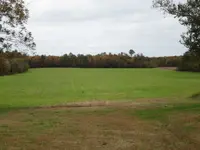 110513a.webp109.2 KB · Views: 233
110513a.webp109.2 KB · Views: 233 -
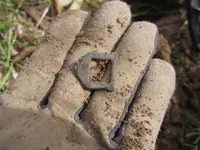 110513b.webp182.7 KB · Views: 267
110513b.webp182.7 KB · Views: 267 -
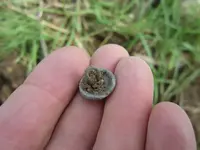 110513c.webp54.6 KB · Views: 251
110513c.webp54.6 KB · Views: 251 -
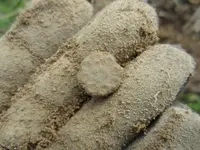 110513d.webp148.6 KB · Views: 239
110513d.webp148.6 KB · Views: 239 -
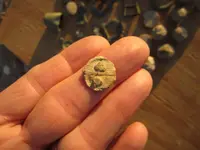 110513l.webp53.1 KB · Views: 262
110513l.webp53.1 KB · Views: 262 -
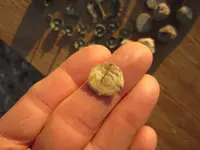 110513k.webp56.2 KB · Views: 265
110513k.webp56.2 KB · Views: 265 -
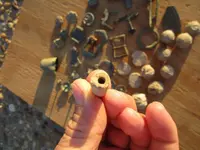 110513j.webp57.3 KB · Views: 240
110513j.webp57.3 KB · Views: 240 -
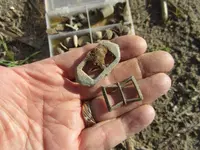 110513h.webp127.8 KB · Views: 255
110513h.webp127.8 KB · Views: 255 -
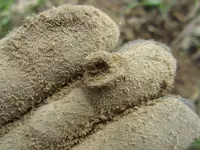 110513e.webp191.9 KB · Views: 249
110513e.webp191.9 KB · Views: 249 -
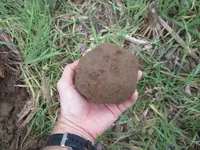 110513f.webp150.8 KB · Views: 242
110513f.webp150.8 KB · Views: 242 -
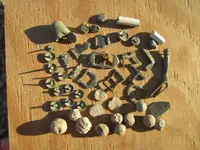 110513ii.webp196.3 KB · Views: 272
110513ii.webp196.3 KB · Views: 272
Last edited:
Upvote
22






